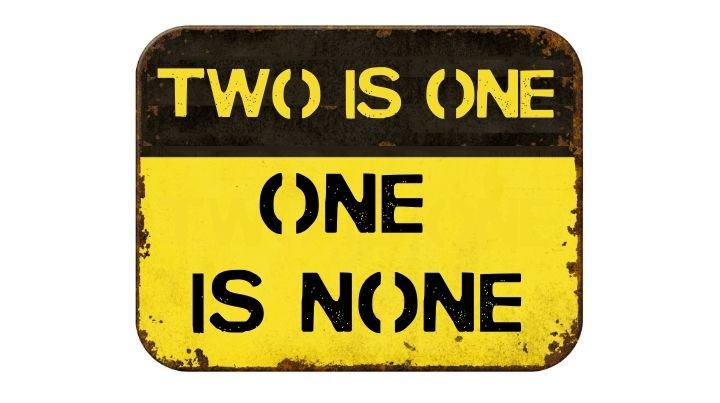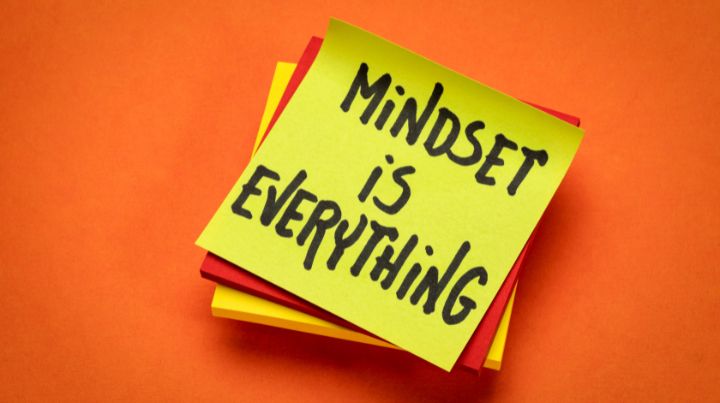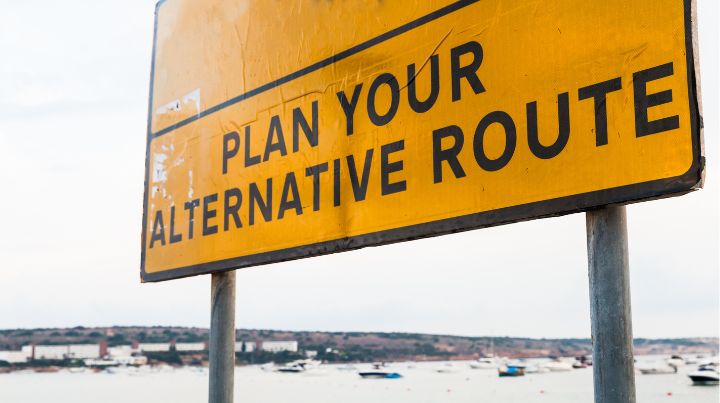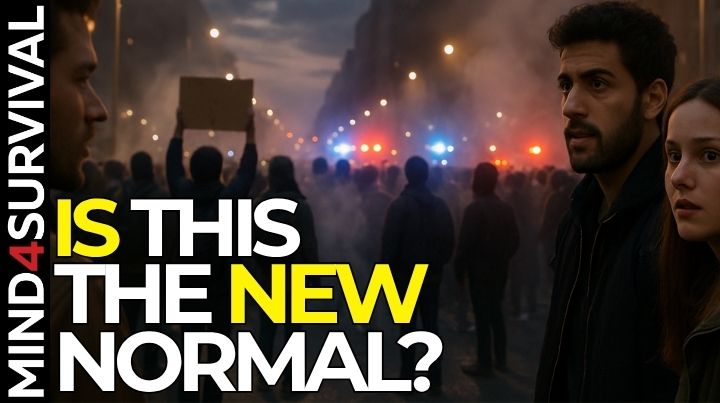Fail-Safe Prepping: Why ‘Two is One, One is None’

If you've read any survival magazine, listened to any preparedness podcast, or watched any readiness-focused YouTube channel, you're sure to have heard the two is one, and one is none mantra repeated time and time again.
And, while on the surface, it's a solid mindset to have when considering your preparedness, it's more in-depth than many people are aware of. That's because there are a few different ways to think of two is one, and one is none when it comes to emergency preparedness and survival.
What is Two is One, One is None
Two is one, and one is none is an excellent method of making sure that you have all of your bases covered in the event your first option fails. That's especially important regarding your survival gear and anything you need to survive a bad situation.
However, the need for redundancy doesn't stop with the items you have in your survival kit. Redundancy applies to all aspects of your ability to survive—knowledge, skills, and resources. Likewise, sometimes, it doesn't apply, meaning having two of something may not be in your best interest.
Why Two is One and One is None is an Essential Mindset

The phrase two is one, and one is none is an essential mindset for survival and preparedness because it emphasizes the importance of having more than one method to accomplish specific goals and tasks. This redundancy means that if one plan or method fails, you have a backup plan in place.
A backup plan can be crucial in emergencies when time is of the essence, and there's no room for error. Having two methods to complete a task can ensure that the job gets done even if one fails. This could mean having two sources of food or water, two ways to start a fire, or two ways to escape a dangerous situation.
The idea behind two is one and one is none also applies to everyday life. Having multiple options for achieving your goals gives you more flexibility and control over your life. It allows you to make decisions based on what works best for you rather than being limited by only one option.
Overall, two is one, and one is none provides an essential reminder that redundancy can be beneficial in many different aspects of life – from emergencies to everyday tasks – and should be considered when planning for any situation.
Redundant Ability
Ability, bookended by mindset and luck, is one of the three factors of the success formula and is a combination of knowledge, skill, and resources. When combined, the factors of ability contribute to whether a person will succeed in whatever it is they are trying to accomplish.
Therefore, it's crucial that anyone who intends to be successful at anything has redundancies built into ensuring they maximize their ability to be successful.
Knowledge
Knowing multiple ways of accomplishing tasks can help in survival and emergencies because it gives you more options for getting the job done. Having a variety of methods to choose from ensures that you have the knowledge in case one strategy fails or is no longer viable. This is especially important for emergency situations when time is precious, and the consequences for failure are potentially high.
For example, knowing different ways to start a fire can be invaluable during an emergency if your primary method isn't available or doesn't work as expected. Knowing how to build a shelter and improvise tools with the materials around you can also come in handy when your basic survival needs are at stake.
In addition to practical skills, knowing multiple approaches related to problem-solving can be beneficial when dealing with unexpected scenarios. Being able to think outside of the box and evaluate various solutions increases your chances of coming up with the optimal solution quickly and efficiently; this is particularly true in dangerous circumstances where time is of the essence, and decisive action is vital.
Overall, knowing multiple ways of achieving tasks can go a long way in keeping people safe and improving their odds of survival during emergencies. Taking the time to gain additional knowledge on different strategies, tactics, and concepts related to everyday activities will ensure that individuals have access to flexible solutions when faced with unforeseen challenges.
Skills
Preparing isn't just about stocking up on supplies and knowing what to do in an emergency. It's also about having the skills to care for yourself and your family. That's why it's important to have redundant skills for accomplishing tasks. If you only know how to do something one way, you will be at a disadvantage when disaster strikes.

For example, knowing how to start a fire without fire starters such as matches or lighters gives you extra options to work with if your go-to method fails. Similarly, collecting and purifying water using different ways will ensure that you won't miss out on vital hydration during an emergency. Additionally, learning how to navigate without the use of modern tools can be invaluable if you need to find your way out of hazardous areas or traverse vast distances with minimal supplies.
Moreover, having a variety of skill sets can be beneficial in everyday activities. If you know multiple ways to complete a task, you'll be able to choose the most efficient method and get the job done quickly. This can help save time and energy, allowing you to focus on more important matters. So, learn how to do as many things as you can. It might just save your life one day.
Resources
The last factor of the capability formula is resources. For preppers, resources include the gear you have available during a survival situation. And, because all resources are subject to breaking or being lost, redundant gear is necessary to avoid a single point of failure.
When I think about having backups to my gear, I consider what is necessary for my most immediate survival needs and build out from there. For example, I place my need for water ahead of my need for food. After all, I can only go a few days without water, whereas I can go much longer without the need for food.
So, I ensure multiple resources for collecting and purifying water. In addition to a stockpile of stored water, I also carry a portable filter, iodine tablets, and a way to boil water so that I can rest assured, knowing that I'll always have access to clean drinking water in an emergency.
By investing in redundant resources based on your risk profile, you can be sure that if one of your items fails, you'll always have a backup.
Flexible Plans

Murphy's Law is always ready to bite each of us in the butt. The fact is, as the military likes to say, “No plan survives initial contact. That's why having a PACE plan is essential. A PACE plan is the two is one, and one is none aspect of planning.
Primary
Your primary plan is the plan you expect to execute. It's the plan you've put the most work into and believe is the most likely to succeed. However, this plan will not always get you to your goal.
Alternate
Your alternate plan is your backup plan in case your primary plan fails. It's the one you put together just in case something goes wrong with the primary plan. This could be based on completely different strategies or tactics and will give you some wiggle room if things don't go as expected.
Contingency
Your contingency plan is your backup to the backup. It's the one you want to execute if both the primary and alternate plans fail. A third option will provide you with multiple paths to success, allowing you to continue working toward your goal even in adverse conditions.
Emergency
Your emergency plan is your absolute last resort. It's the one you execute if all other plans fail, and it will usually involve a complete reorganization of everything you know and do.
Planning ahead with multiple options in mind is the key to success during disaster situations. Two is one, and one is none – ensure enough options are available, so you are never left with nothing. That way, you can be sure that you can survive and thrive in any situation.
Determining When Two is One and One is None Applies to You

Not everything requires a one is none, two is one approach. Constraints such as budget, space, weight, and availability determine whether or not we need redundant capabilities. Moreover, your risk profile should determine how much and how much you need of a particular factor of success.
For example, when I was in the Army Rangers (and I assume this is true with Navy Seals and other special operations units), we were limited by the space and the extra weight of what we could carry. Would having two sets of fragile night vision be considered ideal? Yes, and it was not practical. However, having additional knowledge about our mission or alternate plans didn't take up extra space, only time to prepare.
The same applies to you. Would you like to have double of everything? Well, if you're a prepper like me, you would. However, most of us are limited by budget and storage space. Therefore, hopefully, based on our risk profile, we choose what is most important to have a backup of or a backup to a backup and go from there.
In the end, whoever we say yes to one thing, we're saying no to something else. We only have so much time and attention to study and increase our knowledge. We only have so much time to practice our skills. Likewise, we only have so much room and budget for additional gear.
What are you saying yes to? What are you saying no to?
The Bottom Line of Two is One, and One is None
Having a redundant capability to face any survival situation is a simple idea and good advice. While the strategy of redundancies is essential to preparedness, it's not always practical. What is practical, though, is managing your knowledge, skills, and resources based on the priority of need. Whatever is most important and useful should get the redundancy first, and so on, within the constraints of your risk profile.
What are your thoughts on this article and the two is one, one is none philosophy? Tell us in the comments below!
Additional Resources:
- Top Prepping Tips! (Step-By-Step Survival Guide)
- SHTF Gear: The Essential Gear to Survive SHTF (2023)
- SHTF Plan: 4-Step Guide to Survive Any Disaster (2023)
- Preparedness Planning in 9 Easy Steps
Be safe!

Related Articles
FREE Guide
Read the Best Seller
Join Mind4Survival
Stay informed by joining the Mind4Survival! 100% Secure! 0% Spam!
Affiliate Disclosure...
Mind4Survival is a free, reader-supported information resource. If you make a purchase through our link, we may, at no cost to you, receive an affiliate commission.
Do You Want To Be Ready No Matter What?

Download our free 39-page guide with interactive, 7-Day Emergency Kit Checklist and take the first step toward real preparedness.
- Know exactly where to start.
- Save time and money.
- How-to build a complete Basic Emergency Kit.
- Level up your safety and security.
Join Mind4Survival
Stay informed by joining the Mind4Survival! 100% Secure! 0% Spam!






I’ve been prepping since 2010 and been dragging my wife along for the ride….until the Great Scamdemic TP Shortage hit. I was always saying to my wife, “2 is 1 and 1 is None” when we went Grocery Shopping. The week before the Great TP Shortage, I bought 4 Big Mega Packs of TP. The wife says, “Why the hell did you buy 4 massive packs of TP? We have 2 big packs unopened already.” I told her that I felt like something bad was about to happen and was lead to buy TP.
When the SHTF or more like the TP-HTF, my wife looked at me and smiled. She’s now a full-on prepper and anytime we go shopping she’ll say to herself, “2 is 1 and 1 is None”. I’ve caught her saying it more than once. LOL
Now she wants me to teach her how to shoot. I do have a spare Ruger SP100 .38 special that I was saving for her.
So I got two wives and it turns out two is better than one.